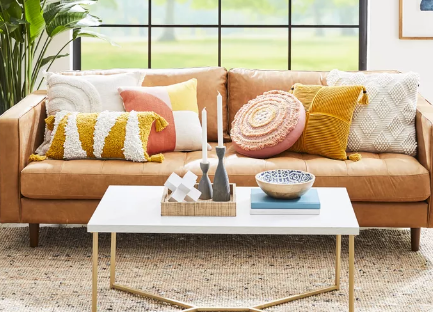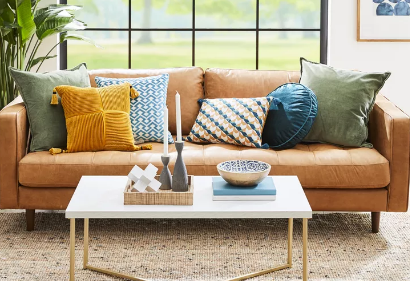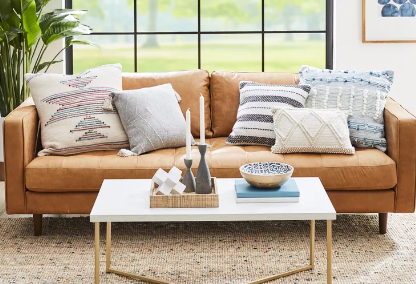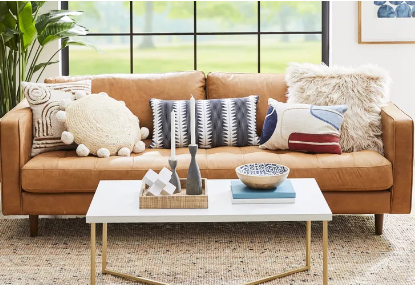Matching a throw pillow is one of the easiest ways to inject style into your living room, family room, or bedroom. With so many affordable, beautiful pillows to choose from, it’s a shame to use just two or three solid color pillows to be on the safe side, or worse, limit yourself to the kit that comes with the couch.

The first thing to remember is that your pillows don’t have to match. In fact, if you don’t, you can achieve a more professional and stylish look. If you’re not satisfied with your ability to choose a pillow, the following tips will help you mix and match fresh patterns and/or colors, allowing you to quickly refresh your room and create a coordinated look rather than looking like a matching set of pillows.
There are many ways to mix and match throw pillows, and it does, and sometimes it does require a skilled eye. Still, even if there isn’t a single pillow in the room that matches another in color, pattern, or style, it’s possible to still look incredibly sophisticated and modern.
If you don’t have the time or inclination to experiment or shop too much, the “rule of three” is the perfect formula to guide you in choosing and streamlining the process.
Why Add a Throw Pillow?
Throw pillows and interchangeable pillowcases provide instant design and personal touch to a room through combinations of colors, patterns, textures, and sizes. But throw pillows also serve a purpose – they make furniture more comfortable. Adding pillows to the corners of sofas and chairs or on top of your bed will give you a cosy feel while also providing extra comfort and support.
How Do I Mix and Match Pillows?
Choose Three Colors
First, choose a “color story” for your pillow selection. It’s best to use three different colors extracted from other sources in the room, such as wall color, carpet, bedding, or curtains. If you choose a variety of pillows with different patterns, the look will still be cohesive as long as they are at least the same color.
Some examples of color combinations always look great:
- Dark blue + dark red + pink
- Crimson + Orange + Dark Green
- Magenta + violet + mustard yellow
- Dark green + gold + magenta
- Sage green + peacock blue + gold

Choose from Three Modes
You can also mix and match three different patterns, as long as each pattern contains at least one color from the tricolor story of your choice. It’s usually simpler to choose the “dominant” pattern first, it’s usually the largest pattern, and it contains all three colors in the color story. The secondary pattern you choose can then contain only one or two colors.
When following the “rule of three”, choose three patterns with different proportions and let one pattern dominate – you don’t want your patterns to compete with each other. Your main pattern should be the largest in this set, followed by a medium-sized print such as a stripe or a small houndstooth. Well, the third pattern should be the most subtle, such as a solid color with an interesting texture, a dotted Swiss pattern, or a pattern with a faint tonal pattern, such as a damask stripe.
Here are some mode blending ideas to try:
- One floral + one geometric + one solid color
- One buffalo check + one calico + one stripe
- One chevron + one polka dot + one knit texture

Choose from Three Sizes
When choosing a pillow size, follow the “rule of three” and choose three different sizes to create design fun. The size grouping depends on the size of the furniture, but it’s important to know the standard pillow size to start planning. Standard square pillows come in sizes of 16 x 16, 18 x 18, 20 x 20, 22 x 22, and 24 x 24 inches. The round pillow is similar in size to the square pillow. Lumbar pillows aren’t as consistent in size as square lumbar pillows, but you should be able to find sizes that are 10 to 16 inches tall and 18 to 22 inches wide, although 12 x 20 inches is a common lumbar pillow size. Adjust the pillow size according to the size of the furniture, mix smaller pillows on a two-seater, and use large or extra-large pillows on sofas and sectional sofas.
When choosing a pillow combination, it can be varied in 2-inch increments, for example, stacking a 22-inch square pillow and a 20-inch square pillow on each corner. In addition to using three different sizes of pillows, you can also use three different shapes (square, round, and rectangular) to create a “three-group rule”.
Here are some pillow size combination ideas to try:
- 24-inch pillows + 22-inch pillows + lumbar
- 22-inch pillows + 20-inch pillows + lumbar
- 20-inch Pillows + 18-inch round + lumbar
- 22-inch pillow + 20-inch square pillow + lumbar pillow
Choose from Three Textures
Pattern and color mixing is important, but texture shouldn’t be overlooked either. Choose three textures that contain contrasting elements but complement each other. Play with the juxtaposition of smooth and rough, soft and fuzzy. Think faux fur, velvet, linen, knitted wool and tassel trims. If you keep your color and pattern theme, you can get creative with touch and feel.
Here’s a classic combination to try, with textures as a feature:
A large pattern + a small pattern + a three-dimensional texture
Break the Rules if You Want
Now that you understand the “rule of three”, we should also say that all rules are meant to be broken – especially in design! If you start mixing and matching your choice of beautiful throw pillows by following the formula outlined here, only to find that four colors work best for you, or you prefer two large patterns over one, that’s okay too. Ultimately, it’s important that you like what you see, so just use this rule of three as a starting point for guidance. If you follow the formula, you’ll see stylish results, but you don’t have to be afraid to experiment until you find a combination that works for you.

Bonus Tips
Once you’ve mastered the rule of thirds, consider other principles used by room designers as well:
- Odd numbers look modern: When arranging pillows, keep in mind that odd numbers work best for a modern look – think three or five more. In most design aesthetics, odd numbers always look more subtle, and keep in mind that a small number of large pillows will look fresher than a bunch of small pillows.
- Even numbers look traditional: To achieve a symmetrical and balanced look, especially on a bed or sofa, even a number of similar pillows, such as two or four, look clean and orderly.
- Padding is important: When buying a throw pillow, consider the padding and its impact on appearance. For example, feather fillings have more “elasticity” and a softer squeezing force. Foam and other synthetic fillers are harder and generally cheaper. These pillows hold their shape better but don’t look as luxurious.
Frequently Asked Questions
What should you wear your pillow with?
When picking a color for your throw pillow, refer to other shades in the room, such as wall colors, rugs, curtains, or a piece of art, to create a cohesive color scheme. Another way is to match your sofa with accent colors. Accentuated pillows can contrast or complement the color of the sofa. You can choose a color that goes with the sofa to add drama, or look for shades from the same color range as the sofa, but don’t match them exactly, for a monochromatic feel.
What is the rule of thumb for pillows?
When placing pillows on the couch, create layers by adding pillows in the corners, starting with the largest pillow in the back and then adding smaller pillows in the front; lumbar pillows can be placed in the center of the couch or in front of the pillow in the corner. For beds, arrange the pillows in an inverted triangle. Start at the back with a European pillow as a base to lean against the headboard, then add pillows from largest to smallest to form a triangle with the tip of the triangle pointing towards the foot of the bed and the bedside table. The pillow can also serve as your base or be hidden behind a European pillow.
How many throw pillows should there be on a couch?
The number of suitable pillows on the sofa depends on the length, depth, and number of corners. A standard two-corner, three-seater sofa that is between 6 and 8 feet long can have 3 to 6 pillows, or 1 to 3 pillows in each corner. For example, a triangular combination can have up to seven pillows, two of which are in the main character and three in the middle corner. Putting too many pillows on a shallow couch can feel cramped, but when the couch is deeper, more pillows will provide more support and comfort.

